Click on images to enlarge
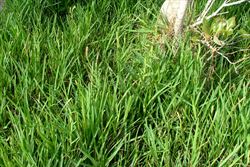
infestation growing amongst mangroves (Photo: Sheldon Navie)
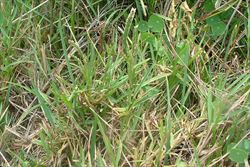
habit (Photo: Sheldon Navie)
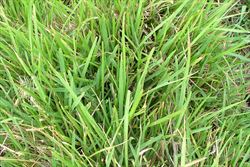
habit (Photo: Sheldon Navie)
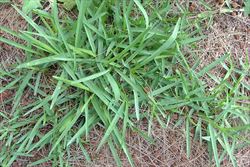
creeping habit (Photo: Sheldon Navie)
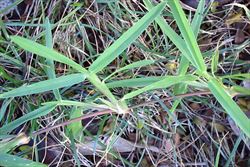
creeping stem producing roots at its joints (Photo: Sheldon Navie)
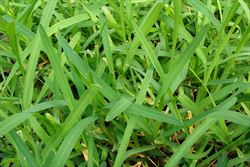
leaves with rounded tips (Photo: Forest and Kim Starr, USGS)
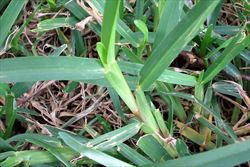
close-up of leaves with folded leaf sheaths (Photo: Sheldon Navie)

seed-heads in flower (Photo: Sheldon Navie)
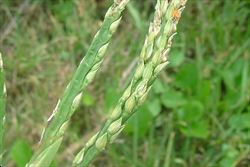
close-up of seed-heads with flower spikelets partially embedded in their broad, flattened, stalks (Photo: Sheldon Navie)
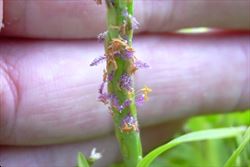
close-up of flower spikelets in flower (Photo: Forest and Kim Starr, USGS)

mature seed-heads (Photo: Sheldon Navie)
Scientific Name
Stenotaphrum secundatum (Walter) Kuntze
Synonyms
Ischaemum secundatum Walter
Family
Gramineae (South Australia)Poaceae (Queensland, New South Wales, the ACT, Victoria, Tasmania, Western Australia and the Northern Territory)
Common Names
buffalo grass, buffalograss, cape quickgrass, carpet grass, coarse couchgrass, coarse quickgrass, coastal buffalo grass, couchgrass, crabgrass, mission grass, pimento grass, quickgrass, St. Augustine grass, St. Augustinegrass, wiregrass
Origin
This species is thought to be native to tropical Africa (i.e. Cameroon, Ivory Coast, Ghana, Liberia, Nigeria, Senegal and Sierra Leone), southern USA (i.e. Florida, south-eastern Georgia, southern Louisiana, southern Mississippi, eastern North Carolina, South Carolina and Texas), eastern Mexico, Central America (i.e. Belize, Costa Rica, Guatemala, Honduras, Nicaragua and Panama), the Caribbean and South America (i.e. French Guiana, Guyana, Surinam, northern Venezuela, eastern Brazil, Bolivia, Colombia, Ecuador, Peru, north-eastern Chile, Paraguay and Uruguay). However, because this species is widely naturalised, its exact native range is obscure.
Cultivation
This species is widely cultivated as a lawn grass, and is particularly common in southern Australia. Several cultivars have been developed for this purpose, two of the most popular in Australia at present being 'Sir Walter' and 'Palmetto'.
Naturalised Distribution
A very widespread introduced lawn grass that is most commonly naturalised in the coastal districts of southern and eastern Australia. It is common in eastern Queensland, eastern New South Wales, Victoria, Tasmania, the southern parts of South Australia, and the southern and south-western parts of Western Australia. Also naturalised on Lord Howe Island and Norfolk Island.
Naturalised overseas in south-eastern Asia, New Zealand and on several Pacific islands (e.g. Fiji, French Polynesia, Hawaii, Kiribati, New Caledonia, Palau, the Solomon Islands and Tonga).
Habitat
A weed of closed forests, forest margins, open woodlands, coastal environs, pastures, gardens, disturbed sites and waste areas in temperate, sub-tropical and tropical regions.
Habit
A long-lived creeping (i.e. stoloniferous perennial) grass usually growing 10-30 cm tall.
Distinguishing Features
- a long-lived creeping grass usually growing 10-30 cm tall.
- it regularly produces roots along its creeping stems and also sends up short upright flowering stems.
- its long and narrow leaves (2-30 cm long and 3-12 mm wide) are often folded lengthwise and usually have rounded tips.
- its seed-heads (3-15 cm long) consist of flower spikelets partially sunken into a broad flattened stalk.
Stems and Leaves
The stems spread extensively over the ground surface, regularly producing roots (i.e. adventitious roots) at their joints (i.e. nodes). Short upright (i.e. erect or ascending) flowering stems (i.e. culms) are also produced off of these creeping stems (i.e. stolons). The stems are usually green, hairless (i.e. glabrous), and are often somewhat flattened (i.e. compressed).
The leaves consist of a leaf sheath, which partially encloses the stem, and a spreading leaf blade. These leaves are alternately arranged along the stems, but may sometimes appear almost paired (i.e. sub-opposite) where the stem joints (i.e. nodes) are very close together. The leaf sheaths (3-6 cm long) are mostly hairless (i.e. glabrous), except for some long hairs near where they join to the leaf blade. They are folded and are usually pale green or whitish towards the base. Where the leaf sheath joins to the leaf blade there is a line of short hairs (i.e. ciliate ligule) about 0.5 mm long. The leaf blades are folded when young, but may be flat or remain folded when they are mature. These leaf blades (2-30 cm long and 3-12 mm wide) have entire margins and, unlike most grasses, they usually have rounded tips (i.e. obtuse apices).
Flowers and Fruit
The seed-heads consist of a broad, flattened, stalk (3-15 cm long) with several very short clusters (i.e. racemes) of flower spikelets partially sunken into it. The flower spikelets (4-6 mm long) are hairless (i.e. glabrous) with pointed tips (i.e. acute apices). They are closely appressed to the main stalk (i.e. rachis), and are borne on smaller stalks (i.e. pedicels) 2-4 mm long. Each flower spikelet consists of a pair of floral bracts (i.e. glumes), one of which is much smaller than the other (i.e. lower glume 0.5-2 mm long and upper glume 4-6 mm long), and two tiny flowers (i.e. florets). The two florets have a pair of bracts (i.e. a lemma and palea), the lower being sterile or having only male flower parts (i.e. three stamens) while the upper also has an ovary and a feathery two-branched stigma.
The 'seeds' (i.e. grains or caryopses) are dark brown, egg-shaped (i.e. ovoid), and about 1.5 mm long. They are shed from the seed-head still contained within the old flower spikelets.
Reproduction and Dispersal
Buffalo grass (Stenotaphrum secundatum) reproduces by seed and also vegetatively via its creeping stems.
This species is often spread to new areas through its cultivation as a lawn and turf grass. Seeds and stem segments are dispersed in dumped garden waste, and may also be spread by water, animals and vehicles.
Environmental Impact
Buffalo grass (Stenotaphrum secundatum) is regarded as an environmental weed in Victoria, Western Australia, New South Wales, South Australia and south-eastern Queensland.
Legislation
Not declared or considered noxious by any state government authorities.

